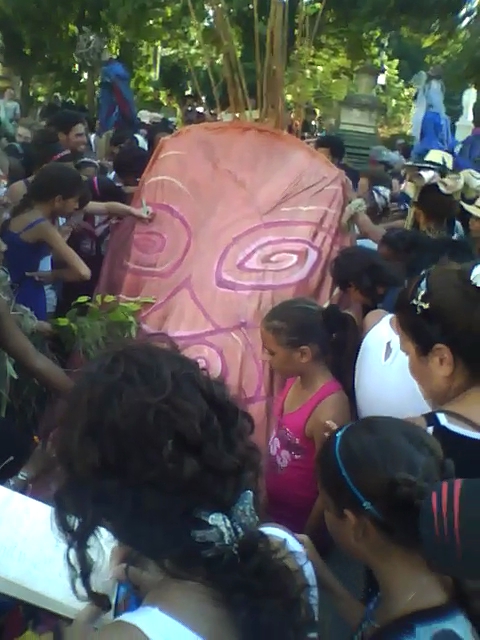The Burning of a Monster
Daisy Valera

Some people paraded on May Day through the former Plaza Civica* (Civic Square). They were either supporting the new policies of the party or simply guaranteeing that they wouldn’t get docked a work day for not showing up – I wasn’t sure.
Other people watched the activities on their TVs at home.
As for me, that day I was among those who turned off the television so as not to unnerve me with the same worn-out lines and the journalists’ detachment from reality.
I had already participated in a march much closer to the hearts of Cuban workers. It was a sincere and festive parade.
This one had not been called by people’s workplaces. Nor had it been announced in the official news media. It began at 5:30 in the afternoon on April 29 in the Plaza de Armas in Old Havana.
That Friday people performed the burning of the Tarasca (a monster), a Cuban tradition that had been celebrated for centuries and that has begun to be reintroduced by the Giganterias, young artists who look to bring happiness to Cubans and foreigners alike with their shows that unfold along the oldest streets in the city.
The death of Tarasca (the monster blamed for all the wrongs of the year) began with a theatrical presentation.
A hysterical king demanded the monster’s immediate death, accusing it of being responsible for the lack of meat and milk in the village.
The King of Tarascon screamed deliriously: “These lands are mine!” That comment was corrected from among the crowd and accompanied by a mocking tone. Yet he continued by saying, “And so are all of you, but you all have to believe in me for me to protect you with my army,” with his message directed to the spectators.
Marta, another character in the dramatization, was opposed to them killing the Tarasca without allowing it to express itself. She argued that he Tarasca hadn’t come to fight but to surrender itself to them so that the wrongs of the world would disappear.
Marta cried out: “Violence breeds violence, and love breeds love!

Another character shouted, “Down with the police, down with the military, down with the merchants who put an end to flowers and songs.
Later they allowed all those present who wanted the monster burned for a better world to write on the hard surface of the giant puppet.
Children and adults rushed over to the Tarasca, and after the ten minutes given to them they had a list of what they wanted to disappear. What they wrote included hate, illnesses, pain, bureaucracy, war, hunger, capitalism, earthquakes and tsunamis, opportunism and fear. But some people also wrote “Down with homophobia” and “May all of us travel freely across the country and around the world.”
But there were many other lines. I was only able to see a small sampling of them.
To the rhythm of the drums, about 800 people then paraded along with the performance artists through the streets of Old Havana until we all got to La Punta (a colonial fortress located at the tip of the Havana seawall and the bay).
At around 7:00 in the evening, Cubans and tourists surrounded the Tarasca, stuffed it with small paper messages and finally the creature was set aflame. A copy of the Granma newspaper was also burned in the fire.
As the blaze grew, so did the happiness and the sound of a conga.
Everyone danced for a good while. By then we were a little more aware of our problems, which can be the first step to facing and solving them.
—
* Renamed “Plaza de la Revolucion” (or “Revolution Square”) following the 1959 revolution.





